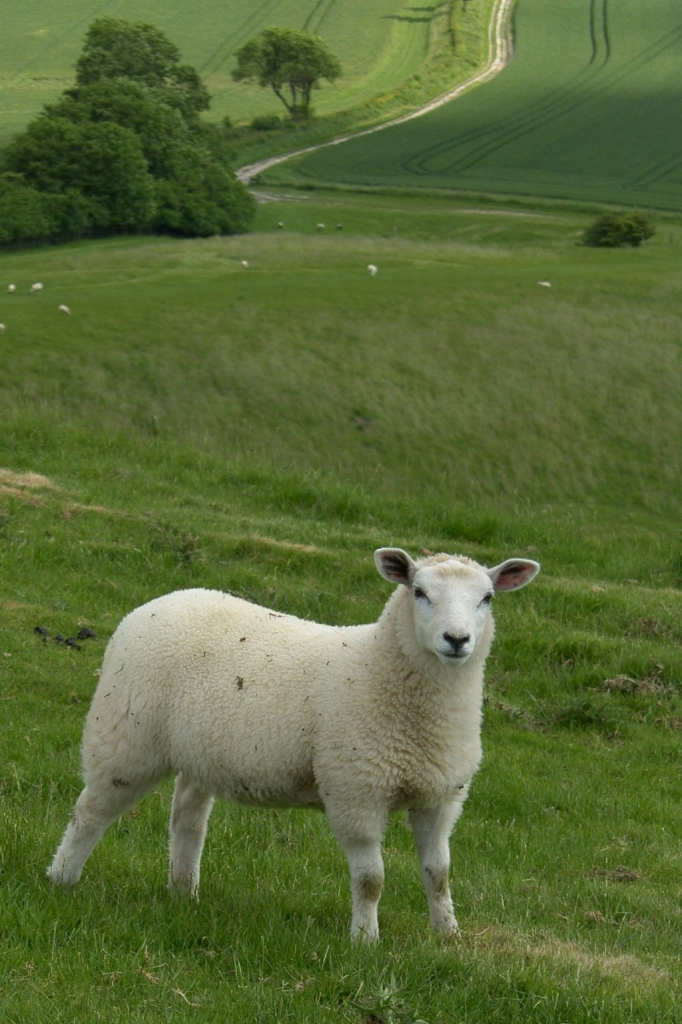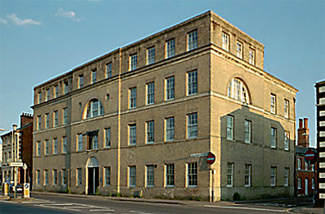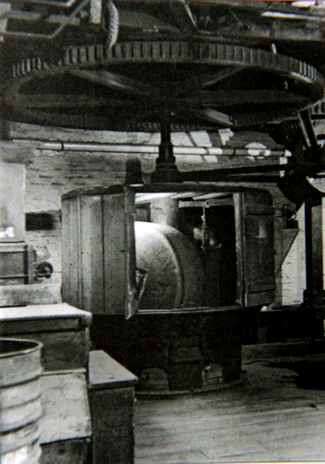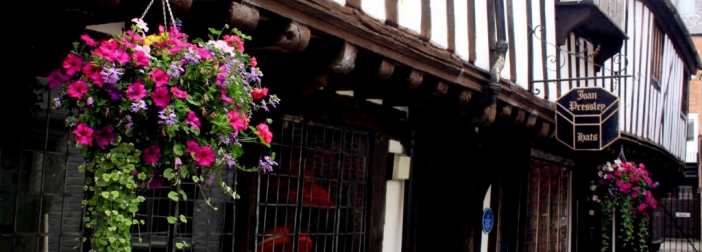by Marlene Lewis, Chairman, Devizes U3A local History Group
Please see also the general article on the woolen and cloth trade in Devizes
John Anstie was born in 1743. His family originated in Battle in Sussex. They were connected by marriage to Sir Edward Baynton, Vice-Chancellor to three of HenryVIII's Queens, who was granted Bromham Manor after the dissolution of Battle Abbey in 1537.
 The
Ansties probably acquired land in Bromham as a result of the Baynton
connection. They appear in the Parish Records from 1570. The family were
principally clothiers from the late 17th century, but John
Ansties father bought a grocery business in Devizes because of a decline
in the woollen trade This was on the corner of New Street (Snuff
Street) and the Market Place. As with many other clothiers, he believed
in diversification and sold pepper, spices and tobacco as well as
clothes. He also took advantage of the popularity of snuff and
subsequently specialised in it. In 1766 he took his two sons as partners
in the snuff trade.
The
Ansties probably acquired land in Bromham as a result of the Baynton
connection. They appear in the Parish Records from 1570. The family were
principally clothiers from the late 17th century, but John
Ansties father bought a grocery business in Devizes because of a decline
in the woollen trade This was on the corner of New Street (Snuff
Street) and the Market Place. As with many other clothiers, he believed
in diversification and sold pepper, spices and tobacco as well as
clothes. He also took advantage of the popularity of snuff and
subsequently specialised in it. In 1766 he took his two sons as partners
in the snuff trade.
In 1784, however, John Anstie paid £500 to quit his third share of the snuff trade because he was more interested in the clothing business. There had been a good export trade in white unfinished cloth, but after the end of the Thirty Years War there was increasing competition from Germany and Holland and, in the West of England production had turned to the new draperies, such as medleys and drugget, which was finer than broadcloth. In 1766 a Bradford-on-Avon clothier had invented cassimeres which was a much finer cloth and which could be patterned and mixed with silk, mohair or cotton to make lightweight coats and waistcoats.
John Anstie saw an opportunity to exploit this new trade and was very successful, becoming a pioneer of new industrial methods. The weaving of cloth had been mainly undertaken in the villages by individual weavers, but the use of carding, scribbling and willeying machines in cloth preparation and the complexity of the process of cassimere production led to the concentration of manufacture in large workshops.

In 1785 John Anstie erected a purpose built manufactory in New Park Street, Right,behind the family's grocery shop. This was on a site formerly occupied by a malt-house and an inn called The Feathers.
It was a four storey building of yellow stock brick with a concealed hipped slate roof and over one hundred windows including bull's eyes and large lunettes. The interior had oak beams and elm joists and a lead rainwater head dated 1785 which bore the initials of John and Mary, his wife.There were lofts with receptacles for wool and yarn, a counting room and various well arranged apartments. It was described as a very capacious building and one of the best workshops in the county. In a street of largely two-storey timbered houses it must have been an impressive sight.
This was one of the first manufactories in the area to house the new scribbling mills and spinning jennies, described as “those great sources of celebrity and dispatch and neatness of execution". In 1795 Anstie's tools of trade included 20 spinning jennies, 1 sloobing machine, a large cloth press, 100 dozen press papers, 200 courses of handles, twisting mills, looms, willow mills, cloth racks and several hundred weight of dye stuffs. It was a large and complex enterprise. He was said to keep 300 looms at work.
In other parts of Wiltshire there had been riots and disturbances with the introduction of the new machines and the bell-ringers at St. John's Church in Devizes composed a new change, “Go to Trowbridge all ye weavers, Knock them down with clubs and cleavers."
John Anstie played a leading role in trying to calm the worker's fears of unemployment and the clothiers' apprehensions of violence. Following a riot of the narrow weavers at Bradford-on-Avon in February 1787, he was asked to chair a meeting of the West of England cassimere manufacturers at the George Inn in Trowbridge where it was agreed that weavers and manufacturers representatives should submit their differing views to the local J.Ps. John Anstie acted as an arbitrator as he admitted that the making of plain cassimeres was only a small proportion of his trade. Anstie was clearly a firm but enlightened employer who paid fair wages and cared for his workers welfare and looked after their interests.
After his father's death in 1779 he had acquired £1,386 16s.10D from the estate and considerably expanded the clothing side of the family firm and centralised his operations under one roof wherever possible. However, because of the shortage of water in Devizes it was still necessary to diffuse his activities to some extent. He probably used horse power for his carding machinery in Devizes but used water power for carding and spinning at Poulshot Mill which he bought in 1791 and which was described as a newly built mill with machinery for carding and spinning wool with a large head of water. In 1777 he rented Rowde Mill from the Norris family of Bromham, acquiring the leasehold for £750 and he purchased a dye house at Snakemead Mill in 1778.
Road improvements in the 18th century were making direct contact with customers more feasible. Devizes, though smaller than Trowbridge, Melksham, Bradford or Westbury, was the site of the County Court, had an important Corn Market and was an ideal business centre. There were five stagecoaches passing through the town daily and a daily postal service to Bristol and London. Two wagons departed for Salisbury every week and three for Bristol, Bath and London. They usually carried Spanish and Saxon wool into town and cloth back. John Anstie was also involved in international trade and sold cloth on commission in the hands of agents in Paris, Hamburg, Frankfurt, Limoges and Lisbon in 1793.
He made valuable London social contacts and looked after his London clients in a meticulous manner. His national reputation as a leading manufacturer was assured by this and other activities in different spheres.
During the 1780s John Anstie became a national political figure largely through the wool export controversy. The trade depression and the halving of long combing at the end of the American war led to the formation of the Lincolnshire Wool Growers Committee in 1782 to press for relaxation of the 1662 laws prohibiting wool exportation; wool in Europe was now fetching three or four times the price in England. Sir Joseph Banks, the scientist, and Arthur Young, the agricultural writer, became their chief spokesmen. The Leeds manufacturers retaliated claiming that such a move would injure the kingdom's trade. So began a 6 year struggle and bitter pamphlet warfare in which Anstie played a leading role. In 1782 he wrote a pamphlet in answer to Sir John Dalrymple's proposal to allow wool export on payment of a tax. He regarded it as the scheme of a few disappointed monopolisers, which would absolutely ruin the Clothing Trade, the only staple commodity this country has left. Anstie attended a meeting in 1784 in the Pelican Inn in Bristol which was called by the manufacturers to protest against the marked increase in smuggling which had led to an alarming decrease in wool for the manufactories. Although Anstie had only attended to observe, he was unanimously elected to the chair. He thus became very involved in trying to protect the manufacturers' rights. He was, however, aware of the difficulty of reconciling wool growers and manufacurers' interests and tried to retain a degree of impartiality.
Throughout Anstie's life, the quality and improvement of British wool was a subject of absorbing interest to him. The financial crisis after the loss of the American Colonies made Britain aware of her dependence on the fine wool of Spain, imports of which cost £750,000 a year especially as the rapidity of enclosure and the concentration on meat rather than fleece in British flocks had coarsened local wool. Anstie wrote "The value of the fleece decreases nearly in proportion to the increased size and weight of the sheep."
Despite his stature as a national figure, Anstie did not shrink from his civic responsibilities. He was closely connected with many local and provincial societies and left his mark on the social and religious life of the district. He was christened in July 1746 in a chapel at the back of a house in the Brittox where Baptists had worshipped for a century. Many leading townsmen belonged to the congregation and the Ansties figured prominently in the church's affairs. Despite his Non-conformity, Anstie was able to hold several civic offices through taking the Oath of Abjuration and Allegiance in the Court of Common Council in 1776. he acted as Grand Juror on 11 January 1790 in the case of Anne Raymond who was sentenced to private whipping and six days imprisonment. From 1775-1777 he served as Overseer of the Poor for St. Mary's Parish. He served the second year voluntarily because he felt a longer term of office would achieve greater continuity and effectiveness although the work involved a great deal of drudgery, one antidote to poverty was the Scribblers Club which was a mutual benefit society for cloth workers in the town and Anstie was treasurer of this club in 1783. he may also have been involved in the running of the Bridewell. At a meeting in 1786 of the Bridewell Committee, resolutions were passed on the exportation of wool with which he was so closely concerned and recommending a reduction in the number of alehouses
In 1771 Anstie joined the Bear Club, a social and philanthropic society founded in 1756. there was a fine of 2s 6d for non-attendance at the annual dinner, members paid an annual subscription of 2s. 6d and 6d.to attend at the Black Bear every Tuesday night at 10o'clock the reckoning was called and absentees were fined 4d. From these funds a school was founded to educate 16 town boys over the age of 10 for 3 years. Instruction in the 3-Rs was accompanied by moral education, particularly eschewing swearing and lying, the grand leaders of all other vices. The boys were to shoe respect to those whom they met, especially to those in stations or degrees above them. The pupils attended church twice on Sunday and were provided annually with a coat, waistcoat, breeches and hat. At the proper age they were apprenticed to a trade. Anstie was elected to the committee in 1784 and remained a club member until 1802.
The late 18th century zeal for improvement, which produced schools and canals, enclosures and hospitals, also spawned Improvement Commissions whose aim was to make streets safer by providing lighting and paving and clearing away refuse. The co-opted members, usually the chief business inhabitants, sought to reinforce the principle of personal obligation which was the basis of English Local Government. Anstie was one of the 97 trustees of the commission set up in Devizes in 1781.
The last quarter of the 18th century produced a large number of associations for the preservation of law and order. The Devizes Society for Prosecuting Felons originated at a meeting on 21st December1787 at the Black Swan. This was attended by Anstie and other leading inhabitants to consider how to protect their persons and property from a wave of petty crime.
Anstie also mixed with a cultured and cosmopolitan set in Bath and joined a Society established in 1777 which called itself “The Bath and West of England Society for the Encouragement of Agriculture, Arts, Manufactures and Commerce." It was addressed to "Gentlemen of Public Character and Liberal Minds in the present age of liberal enquiry." Anstie was elected to the Society's Committee of Manufactures and Commerce, a testimony to his reputation in the area, 8 years before he built his new factory and 5years before the wool controversy. He took an active part in the Society. Premiums were offered for inventions such as spinning jennies for fine cloth, waterproof boots and the use of oil in woollen manufacture among other things.
Anstie bought a house in New Park Street in 1780. it was described as “a messuage or tenement, with a coach house, a barn, stables, outhouses, garden and orchard." Traces of the original 15th century gabled and timber-framed house remain, but the house was refronted in the early 17th. century and in the late 18th century given a plain Bath Stone Georgian front and a porch with 2 stone Doric Columns. His elegant house was appropriate to his status. He appeared as one of the principal gentry of Wiltshire in a 1791 survey and mixed easily with county society.
Like most 18th. century gentlemen, he took snuff using a gilt snuffbox with a pebble in the lid, perhaps one of the famous Bromham quartz pebbles and, if so, a reminder of his family's origin. Ansties contacts and publications show him to be a man of some culture and refinement. In his pamphlets he shows a good grasp of general historical developments. He had a wide knowledge of European economic affairs and had critically read Adam Smith's Wealth of Nations. He was a
subscriber to a book published in Devizes in 1773 entitled "The way to the temple of true honour and fame by the paths of Heroic virtue, which is in the Wiltshire Museum library in Devizes. His style was lucid and cultured.

The prosperous and dynamic pattern of Anstie's life was shattered by increasing stress, ill health and ultimately business failure. Despite living to be 87, he was occasionally plagued by ill health. Although Anstie described his situation in 1789 as "affluent", with property worth £20,000, he had borrowed heavily from his father, brother and sister to set up his business. His account book shows latent financial problems from 1788, when he borrowed £2,186. 18s 4d from his brother at 5% interest. His brother Benjamin's snuff business was prospering and he also paid £856.5s. in 1789 to settle some outstanding bills. In 1788 Anstie borrowed £2,500 from the banks and £200 from his mother. By August 1790 he owed Stephen Hillman £500 for wool, but was only able to pay £125 a year in 1791 and 92, the rest accruing interest. There were evidently some serious cash flow problems. The rise in the price of Spanish wool, Anstie's concentration on the European luxury market and the financial crisis of 1793 all played their part in his downfall.
Above an Anstie's snuff grinding mill
Perhaps from the start he was over committed. He had 10 establishments
employed for various processes around Devizes, largely due to the lack of water in the town, which prevented him from fully centralising and mechanising his operations. He had not invested heavily in land and so had little diverse property to mortgage to stave off financial ruin.
Ansties bankruptcy was announced in the London Gazette on 7th December 1793. To meet some of his debts it was proposed to sell £20,000 worth of goods and to take out a £15,000 loan. Anstie was anxious that his employees should not suffer from his financial collapse. Henry Collins, a servant, was paid eight month's salary and lent £6 in cash for his present need. In a letter of 1808 Anstie revealed that he had sunk a considerable sum of money by keeping employed, from motives of humanity and public spiritedness, a very great number of persons in the critical year of 1792.
Anstie moved to Rowde where he leased a small house, close and barn.
He spent £12 improving the house but was clearly dependent on the charity of his brother. Anstie
seems to have lived in Rowde for about 10years but seems to have withdrawn from local public life or perhaps moved to another area after that time. It was obviously galling for him to be wholly dependent on others for his support. His own ultimate estate of £942 suggests considerably straitened circumstances.
Much of Anstie's land and property was sold or taken over by his brother Benjamin who converted Poulshot Mill for snuff grinding. Anstie's Devizes factory was leased to the Overseers of the poor as a House of Industry. The family's woollen trade continued on a small scale for a little over 10years. An early 19th century clothier's pattern book lists the Anstie's order for a sober, plain black cloth under Sundry Persons, - a sad contrast when John Anstie's cloth was on sale in the capitals of Europe.
John Anstie died in October 1830 on Wilson Street, Bristol and was buried in St. Paul's Churchyard, Portland Square. His obituary in the Devizes Gazette paid tribute to his innovations in wool manufacture and his activities in the national economic sphere.
Anstie's short but brilliant career reflects some important trends in 18th century life: the Enlightenment, the belief that conditions could be improved by thought and effort; the awakening interest in science and technology; the growing humanitarianism and philanthropy of the age; the manufacturers increasing influence and contribution in public life. In the eyes of Devizes historian James Waylen, Anstie exerted an influence of which he commanded and extensive share in the advancement of objects of a patriotic kind. He was not only an eminent woollen manufacturer but a citizen in the best sense of the word. He represents the caring 18th century capitalist with considerable leadership qualities, intellectual vigour and social conscience for whom service to his country ran like a silk thread through the web of his life.
Please see also the general article on the woolen and cloth trade in Devizes



